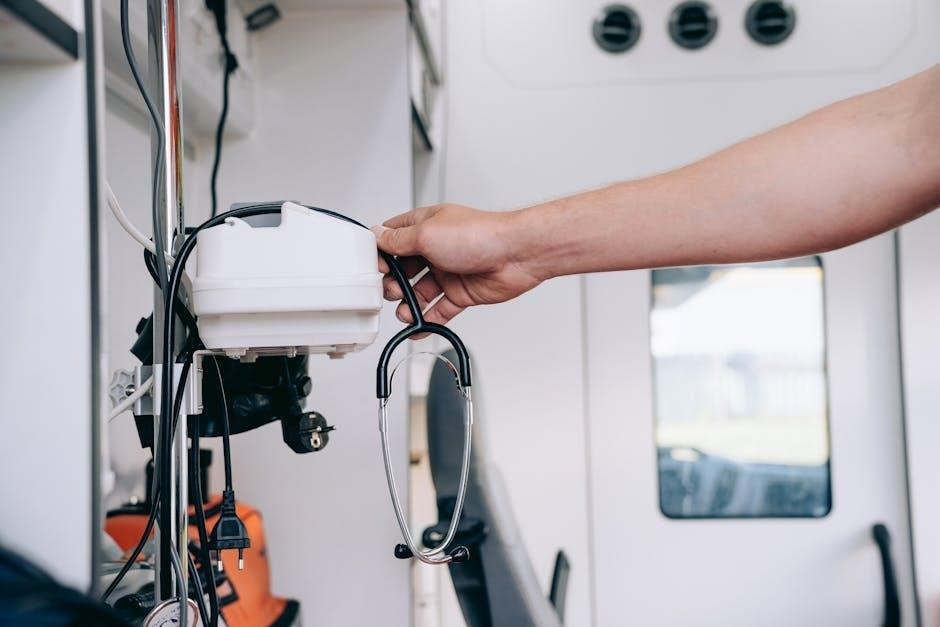Critical care is a specialized medical field focusing on life-sustaining interventions for critically ill patients. It is delivered across various healthcare settings, not just ICUs, ensuring continuous care.
1.1 What is Critical Care?
Critical care is specialized medical attention for patients with life-threatening conditions requiring close, constant monitoring and support. It involves advanced interventions, such as mechanical ventilation and hemodynamic monitoring, to stabilize vital functions. Delivered by multidisciplinary teams, critical care bridges the gap between life and recovery, focusing on patient-centered approaches to address complex medical needs effectively.
1.2 Importance of Critical Care in Modern Medicine
Critical care is vital in modern medicine, providing life-sustaining interventions for patients with severe, complex conditions. It serves as a continuum of care, extending beyond ICUs to emergency and recovery settings. Specialized teams ensure optimal patient outcomes, making critical care indispensable in managing emergencies, post-surgical recovery, and chronic disease exacerbations, integrating advanced technology and evidence-based practices to save lives and improve quality of care.
Prioritizing Patient Safety and Comfort
Patient safety and comfort are paramount in critical care. Ensuring infection prevention, monitoring, and addressing discomfort helps create a therapeutic environment, promoting recovery and trust in care.
2.1 First Things First: Patient Safety
Patient safety is the cornerstone of critical care. Prioritizing safety involves preventing infections, ensuring proper medication administration, and monitoring for complications. Establishing clear communication and protocols minimizes errors, while regular assessments and documentation maintain high standards of care, ensuring patient well-being and optimal outcomes in high-stakes environments.
2.2 Ensuring Patient Comfort in Critical Care Settings
Patient comfort is vital in critical care, enhancing recovery and reducing stress. Strategies include pain management, emotional support, and addressing physical needs. Clear communication and empathy help alleviate anxiety, while creating a calming environment with appropriate lighting and noise control promotes relaxation. Prioritizing comfort fosters a patient-centered approach, improving overall well-being and satisfaction in intensive care settings.

Initial Patient Assessment and Management
Initial assessment involves taking an AMPLE history and stabilizing vital functions. Prioritize patient safety, ensuring comfort and addressing immediate needs to lay a foundation for recovery.
3.1 Conducting an AMPLE History
An AMPLE history is a systematic approach to gathering critical patient information: Allergies, Medications, Past medical history, Last meal, and Events leading to the current condition. This structured method ensures comprehensive data collection, aiding in accurate diagnoses and tailored treatment plans, while prioritizing patient safety and comfort in critical care settings.
3.2 Initial Assessment and Stabilization Techniques
Initial assessment focuses on evaluating the patient’s airway, breathing, circulation, disability, and exposure (ABCDE approach). Stabilization involves addressing immediate threats, such as securing the airway or restoring blood pressure. Techniques include mechanical ventilation, fluid resuscitation, and vasopressor use. Prioritizing patient safety and comfort ensures effective care and prevents further complications in critical situations.
Hemodynamic Monitoring and Management
Hemodynamic monitoring assesses blood pressure, fluid status, and cardiac function to guide treatment. Tools like Swan-Ganz catheters help manage shock, optimize perfusion, and stabilize critically ill patients effectively.
4.1 Basics of Hemodynamic Monitoring
Hemodynamic monitoring involves assessing blood pressure, fluid status, and cardiac function to evaluate a patient’s circulatory system. Key parameters include heart rate, blood pressure, and central venous pressure. Tools like arterial lines and central venous catheters provide real-time data, guiding fluid therapy, vasopressor use, and overall management. Accurate interpretation of these metrics is crucial for optimizing perfusion and ensuring patient stability in critical care settings.
4.2 Advanced Hemodynamic Monitoring Techniques
Advanced hemodynamic monitoring employs tools like pulmonary artery catheters and transpulmonary thermodilution to assess cardiac output and preload. These techniques provide detailed insights into ventricular function and fluid responsiveness. Less invasive methods, such as pulse contour analysis, offer continuous monitoring. Advanced monitoring guides precise titration of therapies, optimizing perfusion and improving patient outcomes in complex critical care scenarios.

Mechanical Ventilation in Critical Care
Mechanical ventilation is a life-saving intervention for patients with respiratory failure. It supports breathing, enhances oxygenation, and reduces work of breathing, balancing comfort with therapeutic goals.
5.1 Basics of Mechanical Ventilation
Mechanical ventilation supports patients with respiratory failure by delivering controlled breaths. Key components include ventilator settings, modes (e.g., volume or pressure-controlled), and alarms. Ensuring patient-ventilator synchrony is crucial, as is proper humidification and suctioning. Adjustments are made based on clinical response to optimize oxygenation, reduce discomfort, and prevent complications.
5.2 Advanced Ventilation Strategies and Liberation
Advanced ventilation strategies focus on optimizing patient outcomes through tailored approaches. Liberation from mechanical ventilation involves careful assessment of readiness, often using spontaneous breathing trials. Strategies like non-invasive ventilation (NIV) and high-flow nasal oxygen (HFNO) are employed to reduce intubation risks. Minimizing sedation and ensuring proper cuff management are critical. Synchronized ventilation modes improve patient comfort and lung mechanics, while multi-disciplinary teams facilitate successful weaning.
Neurological Care in the ICU
Neurological care in the ICU focuses on managing brain and nervous system injuries. It includes monitoring intracranial pressure, ensuring cerebral perfusion, and preventing secondary brain injuries through targeted interventions.
6.1 Managing Intracranial Pressure (ICP)
Managing elevated ICP involves a multimodal approach, including osmotic therapy, sedation, and surgical interventions. Monitoring cerebral perfusion pressure is crucial to ensure adequate blood flow to the brain, preventing further damage. Protocols may vary based on patient-specific factors and institutional guidelines to optimize neurological outcomes in critically ill patients.
6.2 Neurological Assessment and Monitoring
Regular neurological assessments are vital to detect subtle changes in a patient’s condition. The Glasgow Coma Scale (GCS) is a cornerstone for evaluating consciousness. Monitoring vital signs, such as cerebral perfusion pressure, and using imaging techniques like CT scans, helps identify potential complications early. Continuous EEG and neuromuscular assessments further guide targeted interventions to preserve neurological function and improve outcomes in critically ill patients.
Pharmacology in Critical Care
Pharmacology in critical care involves using medications like vasoactive drugs, sedatives, and analgesics to manage hemodynamics and patient comfort. Understanding drug interactions and dosing adjustments is crucial for optimizing outcomes.
7.1 Common Medications in Critical Care
In critical care, common medications include vasoactive drugs like norepinephrine and epinephrine for hemodynamic support, analgesics such as fentanyl, and sedatives like propofol. Anticoagulants like heparin and dalteparin are used to prevent thrombosis. These medications require precise dosing and monitoring to ensure efficacy and minimize adverse effects, making them essential tools in managing critically ill patients effectively.
7.2 Use of ECMO and Impella Devices
ECMO (Extracorporeal Membrane Oxygenation) and Impella devices are advanced tools in critical care. ECMO supports oxygenation when heart or lung function fails, while Impella provides mechanical cardiac support. These devices are crucial for managing severe cardiac or respiratory failure, offering a bridge to recovery or further intervention. Their use requires specialized expertise and close monitoring to optimize patient outcomes effectively.

Infection Control and Antibiotic Stewardship
Infection control is vital in critical care to prevent hospital-acquired infections. Antibiotic stewardship ensures responsible use of antibiotics, optimizing effectiveness and reducing resistance. Both are cornerstone practices.
8.1 Preventing Infections in the ICU
Infection prevention in the ICU is critical due to vulnerable patients. Key strategies include strict hand hygiene, use of personal protective equipment, isolation protocols, and environmental cleaning. Proper sterilization of equipment and adherence to antimicrobial stewardship programs are essential to reduce infection risks and improve patient outcomes in critical care settings.
8.2 Antibiotic Stewardship Programs
Antibiotic stewardship programs (ASPs) are essential in critical care to optimize antibiotic use, ensuring efficacy while minimizing resistance. Strategies include de-escalation, dose optimization, and monitoring. ASPs improve patient outcomes, reduce antibiotic-associated harm, and combat antimicrobial resistance, making them a cornerstone of modern infection control in intensive care settings.

Continuous Learning and Professional Development
Critical care professionals must stay updated with the latest research and guidelines to provide optimal care. Continuous learning through literature, workshops, and hands-on training is essential for proficiency and patient safety.
9.1 Staying Updated with Critical Care Literature
Staying current with critical care literature is essential for delivering evidence-based care. Regularly review journals, guidelines, and updates to enhance clinical decision-making. Utilize resources like ICU survival guides and professional society recommendations to stay informed. Incorporate new findings into practice to improve patient outcomes and maintain professional competence in a rapidly evolving field.
9.2 Opportunities for Learning on the Job
Learning on the job is vital in critical care, where hands-on experience shapes proficiency. Engage with diverse patient cases, seek mentorship, and participate in bedside teaching. Use resources like the Critical Care Survival Guide to enhance skills. Embrace challenges as opportunities to grow, fostering expertise in high-stakes environments and staying adaptable to evolving patient needs and medical advancements.
Critical care demands continuous learning and adaptability, with healthcare professionals playing a vital role in advancing patient care through updated practices and hands-on expertise.
10.1 Key Takeaways for Critical Care Professionals
Critical care professionals must prioritize patient safety, stay updated with the latest literature, and seize learning opportunities to enhance their skills. Effective communication and collaboration with multidisciplinary teams are essential. Continuous learning and adaptability ensure optimal patient outcomes in dynamic ICU settings. These principles guide professionals in delivering compassionate and evidence-based care, fostering a culture of excellence in critical care medicine.
10.2 The Future of Critical Care Medicine
The future of critical care medicine lies in advancing technologies like ECMO and Impella, personalized medicine, and targeted therapies. Interdisciplinary collaboration and innovative monitoring tools will enhance patient outcomes. As the field evolves, integrating AI and precision medicine will play a pivotal role in shaping tomorrow’s ICU practices, ensuring more tailored and effective care for critically ill patients.
